Periodic Classification of Elements | Chemistry - Periodic Trends in Properties | 11th Chemistry : UNIT 3 : Periodic Classification of Elements
Chapter: 11th Chemistry : UNIT 3 : Periodic Classification of Elements
Periodic Trends in Properties
Periodic
Trends in Properties
As discussed earlier, the electronic configuration of the
elements shows a periodic variation with increase in atomic numbers. Similarly
a periodic trend is observed in physical and chemical behaviour of elements. In
this section, we will study the periodic trends in the following properties of
elements.
1. Atomic radius
2. Ionic radius
3. Ionisation enthalpy (energy)
4. Electron gain enthalpy (electron affinity)
5. Electronegativity
1. Atomic radius
Atomic radius of an atom is defined as the distance between
the centre of its nucleus and the outermost shell containing the valence
electron.
It is not possible to measure the radius of an isolated
atom directly. Except for noble gases, usually atomic radius is referred to as
covalent radius or metallic radius depending upon the nature of bonding between
the concerned atoms.
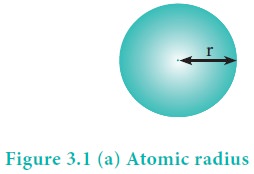
Covalent radius
It is one-half of the internuclear distance between two
identical atoms linked together by a single covalent bond. Inter nuclear
distance can be determined using x-ray diffraction studies.
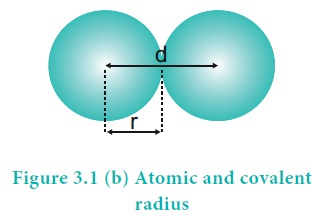
Example:
The experimental internuclear distance in Cl2
molecule is 1.98 ├ģ. The covalent radius of chlorine is calculated as below.
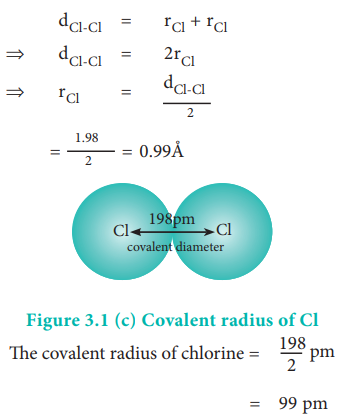
The formation of covalent bond involves the overlapping of
atomic orbitals and it reduces the expected internuclear distance. Therefore
covalent radius is always shorter than the actual atomic radius.
The covalent radius of individual atom can also be
calculated using the internuclear distance (dA-B) between two
different atoms A and B. The simplest method proposed by Schomaker and
Stevenson is as follows.
dA-B = rA + rB - 0.09 (ŽćA-ŽćB)
where ŽćA and ŽćB are the electronegativities of A and B respectively in Pauling units
Here ŽćA ŽćB and radius is in ├ģ.
Let us calculate the covalent radius of
hydrogen using the experimental d value is 1.28 ├ģ and the covalent
radius of chlorine is 0.99 ├ģ. In pauling scale the electronegativity of chlorine and
hydrogen are 3 and 2.1 respectively.
dH-Cl = rH + rCl - 0.09 (
ŽćCl - ŽćH)
1.28 = rH + 0.09 - 0.09 (3 - 2.1)
1.28 = rH + 0.09 - 0.09 (0.9)
1.28 = rH + 0.09 - 0.081
1.28 = rH + 0.909
Ōł┤ rH = 1.28 - 0.909 =
0.317 ├ģ
Metallic radius
It is defined as one-half of the distance between two
adjacent metal atoms in the closely packed metallic crystal lattice.
For example, the distance between the adjacent copper
atoms in solid copper is 2.56 ├ģ and therefore the metallic radius of copper is

The metallic radius can be calculated using the unit cell
length of the metallic crystal. You will study the detailed calculation
procedure in XII standard solid state unit.
Periodic Trends in Atomic Radius
Variation in Periods
Atomic radius tends to decrease in a period. As we move
from left to right along a period, the valence electrons are added to the same
shell. The simultaneous addition of protons to the nucleus, increases the
nuclear charge, as well as the electrostatic attractive force between the valence
electrons and the nucleus. Therefore atomic radius decreases along a period.
Effective nuclear charge
In addition to the electrostatic forces of attraction
between the nucleus and the electrons, there exists repulsive forces among the
electrons. The repulsive force between the inner shell electrons and the
valence electrons leads to a decrease in the electrostatic attractive forces
acting on the valence electrons by the nucleus. Thus, the inner shell electrons
act as a shield between the nucleus and the valence electrons. This effect is
called shielding effect.
The net nuclear charge experienced by valence electrons in
the outermost shell is called the effective nuclear charge. It is approximated
by the below mentioned equation.
Zeff = Z ŌĆō S
Where Z is the atomic number and 'S' is the screening
constant which can be calculated usi ng Slater's rules as described below.
Step 1 :
Write the electronic configuration of the atom and
rearrange it by grouping ns and np orbitals together and others separately in
the following form.
(1s) (2s, 2p) (3s, 3p) (3d) (4s, 4p) (4d) (4f) (5s, 5p)...
Step 2 :
Identify the group in which the electron of interest is
present. The electron present right to this group does not contribute to the
shielding effect.
Each of the electrons within the identified group (denoted
by 'n') shields to an extent of 0.35 unit of nuclear charge. However, it is
0.30 unit for 1s electron.
Step 3 :
Shielding of inner shell electrons.
If the electron of interest belongs to either s or p orbital,
i) each electron within the (n-1) group shields to an
extent of 0.85 unit of nuclear charge, and
ii) each electron within the (n-2) group (or) even lesser
group (n-3, (n-4) etc...completely shields i.e. to an extent of 1.00 unit of
nuclear charge.
If the electron of interest belongs to d or f orbital,
then each of electron left of the group of electron of interest shields to an
extent of 1.00 unit of nuclear charge.
Step 4 :
Summation of the shielding effect of all the electrons
gives the shielding constant 'S'
Example: Let us explain the calculation of effective nuclear charge on 4s
electron and 3d electron in scandium. The electronic configuration of scandium
is 1s2, 2s2, 2p6, 3s 2, 3p6,
4s2, 3d1. we can rearrange as below.
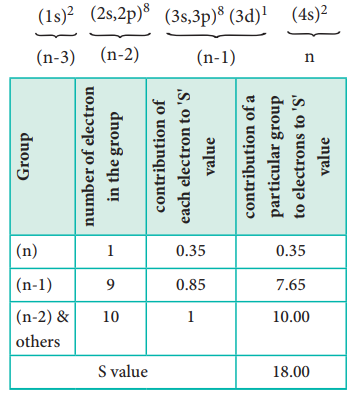
Zeff = Z ŌĆō S i.e.= 21- 18 Ōł┤Zeff = 3
Calculation of effective nuclear charge on 3d electron
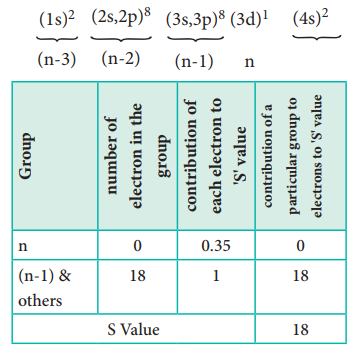
Ōł┤ Zeff = Z ŌĆō
S i.e. =21 ŌĆō 18 Ōł┤ Zeff = 3
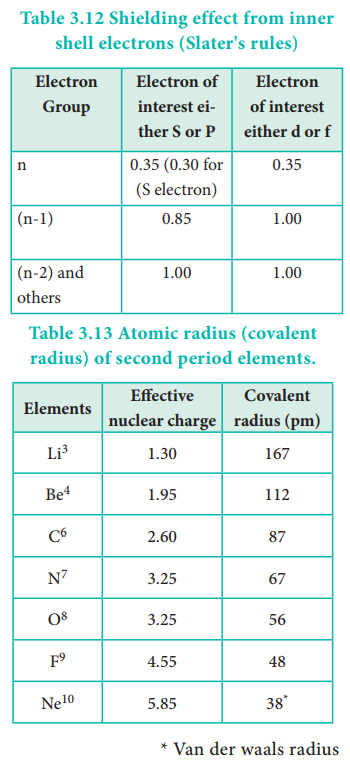
Variation in Group
In the periodic table, the atomic radius of elements
increases down the group. As we move down a group, new shells are opened to
accommodate the newly added valence electrons. As a result, the distance
between the centre of the nucleus and the outermost shell containing the
valence electron increases. Hence, the atomic radius increases. The trend in
the variation of the atomic radius of the alkali metals down the group os shown
below.

Activity 3.1
Covalent radii (in ├ģ) for some elements of different
groups and periods are listed below. Plot these values against atomic number.
From the plot, explain the variation along a period and a group.
2nd group elements : Be (0.89), Mg (1.36), Ca
(1.74), Sr (1.91) Ba(1.98)
17th group elements : F (0.72), Cl (0.99), Br
(1.14), I (1.33)
3rd Period elements : Na(1.57), Mg(1.36), Al
(1.25), Si(1.17), P(1.10), S(1.04), Cl(0.99)
4th period elements : K(2.03), Ca(1.74),
Sc(1.44), Ti(1.32), V(1.22), Cr(1.17), Mn(1.17), Fe(1.17), Co(1.16), Ni(1.15),
Cu(1.17), Zn(1.25), Ga(1.25), Ge(1.22), As(1.21), Se(1.14), Br(1.14)
2. Ionic radius
It is defined as the distance from the centre of the
nucleus of the ion up to which it exerts its influence on the electron cloud of
the ion. Ionic radius of uni-univalent crystal can be calculated using
Pauling's method from the inter ionic distance between the nuclei of the cation
and anion. Pauling assumed that ions present in a crystal lattice are perfect
spheres, and they are in contact with each other therefore,
d = rC+ + rA-
------------------ (1)
Where d is the distance between the centre of the nucleus
of cation C+ and anion A- and rC+,
r A- are the radius of the cation and anion respectively.
Pauling also assumed that the radius of the ion having noble
gas electronic configuration (Na+ and Cl-having 1s2
2s2, 2p6 configuration) is inversely proportional to the effective
nuclear charge felt at the periphery of the ion.
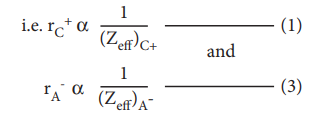
Where Zeff is the effective nuclear charge and
Zeff = Z - S
Dividing the equation 1 by 3

On solving equation (1) and ( 4 ) the values of rC+and rA- can be obtained
Let us explain this method by calculating the ionic radii
of Na+ and F- in NaF crystal whose interionic distance is
equal to 231 pm .
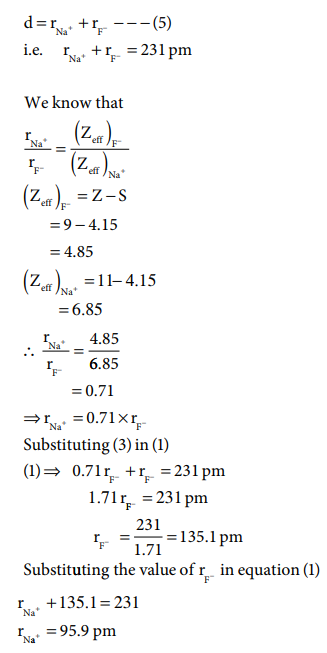
3. Ionisation energy
It is defined as the minimum amount of energy required to
remove the most loosely bound electron from the valence shell of the isolated
neutral gaseous atom in its ground state. It is expressed in kJ mol-1
or in electron volts (eV).
M(g) + IE1 ŌåÆ M+(g) + 1 e-
Where IE1 represents the first ionisation
energy.
Successive Ionisation energies
The minimum amount of energy required to remove an
electron from a unipositive cation is called second ionisation energy. It is
represented by the following equation.
M+(g) + IE2 ŌåÆ M2+(g)+ 1 e-
In this way we can define the successive ionisation
energies such as third, fourth etc.
The total number of electrons are less in the cation than
the neutral atom while the nuclear charge remains the same. Therefore the
effective nuclear charge of the cation is higher than the corresponding neutral
atom. Thus the successive ionisation energies, always increase in the following
order
IE1 < IE2 < IE3
< .....
Periodic Trends in Ionisation Energy
The ionisation energy usually increases along a period
with few exceptions. As discussed earlier, when we move from left to right
along a period, the valence electrons are added to the same shell, at the same
time protons are added to the nucleus. This successive increase of nuclear
charge increases the electrostatic attractive force on the valence electron and
more energy is required to remove the valence electron resulting in high
ionisation energy.
Let us consider the variation in ionisation energy of second
period elements. The plot of atomic number vs ionisation energy is given below.
In the following graph, there are two deviation in the
trends of ionisiation energy. It is expected that boron has higher ionisation
energy than beryllium since it has higher nuclear charge. However, the actual
ionisation energies of beryllium and boron are 899 and 800 kJ mol-1
respectively contrary to the expectation. It is due to the fact that beryllium
with completely filled 2s orbital, is more stable than partially filled valence
shell electronic configuration of boron. (2s2,2p1)
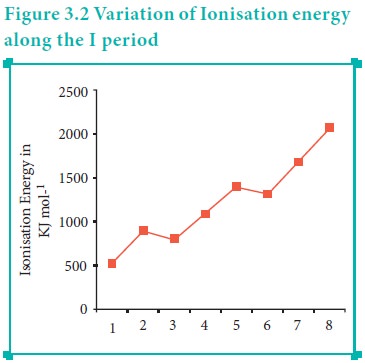
The electronic configuration of beryllium (Z=4) in its
ground state is 1s2, 2s2 and that of boran (Z = 5) 1s2
2s2 2p1
Similarly, nitrogen with 1s2, 2s2,
2p3 electronic configuration has higher ionisation energy (1402 kJ
mol-1) than oxygen (1314 kJ mol-1). Since the half filled
electronic configuration is more stable, it requires higher energy to remove an
electron from 2p orbital of nitrogen. Whereas the removal one 2p electron from
oxygen leads to a stable half filled configuration. This makes comparatively
easier to remove 2p electron from oxygen.
Periodic variation in group
The ionisation energy decreases down a group. As we move
down a group, the valence electron occupies new shells, the distance between
the nucleus and the valence electron increases. So, the nuclear forces of attraction
on valence electron decreases and hence ionisation energy also decreases down a
group.
Ionisation energy and shielding effect
As we move down a group, the number of inner shell
electron increases which in turn increases the repulsive force exerted by them
on the valence electrons, i.e. the increased shielding effect caused by the
inner electrons decreases the attractive force acting on the valence electron
by the nucleus. Therefore the ionisation energy decreases.
Let us understand this trend by considering the ionisation
energy of alkali metals.
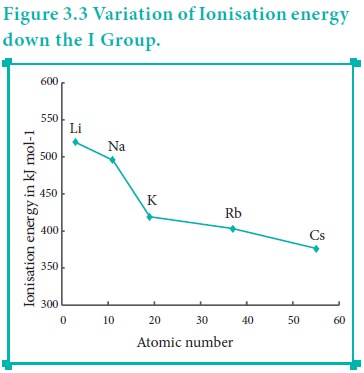
4. Electron Affinity
It is defined as the amount of energy released (required
in the case noble gases) when an electron is added to the valence shell of an
isolated neutral gaseous atom in its ground state to form its anion. It is
expressed in kJ mol-1
A + 1 e- ŌåÆ A- + EA
Variation of Electron Affinity in a period:
The variation of electron affinity is not as systematic as
in the case of ionisation energy. As we move from alkali metals to halogens in
a period, generally electron affinity increases, i.e. the amount of energy
released will be more. This is due to an increase in the nuclear charge and
decrease in size of the atoms. However, in case of elements such as beryllium
(1s2, 2s2), nitrogen (1s 2, 2s 2,
2p3) the addition of extra electron will disturb their stable
electronic configuration and they have almost zero electron affinity.

Noble gases have stable ns2, np6
configuration, and the addition of further electron is unfavourable and
requires energy. Halogens having the general electronic configuration of ns2,
np5 readily accept an electron to get the stable noble gas
electronic configuration (ns2, np6), and therefore in
each period the halogen has high electron affinity. (high negative values)
Variation of Electron affinity in a group:
As we move down a group, generally the electron affinity
decreases. It is due to increase in atomic size and the shielding effect of
inner shell electrons. However, oxygen and fluorine have lower affinity than
sulphur and chlorine respectively. The sizes of oxygen and fluorine atoms are
comparatively small and they have high electron density. Moreover, the extra
electron added to oxygen and fluorine has to be accommodated in the 2p orbital
which is relatively compact compared to the 3p orbital of sulphur and chlorine
so, oxygen and fluorine have lower electron affinity than their respective
group elements sulphur and chlorine.
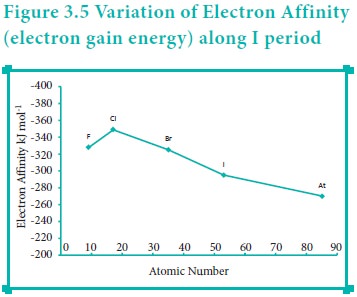
5. Electronegativity:
It is defined as the relative tendency of an element
present in a covalently bonded molecule, to attract the shared pair of
electrons towards itself.
Electronegativity is not a measurable quantity. However, a
number of scales are available to calculate its value. One such method was
developed by Pauling, he assigned arbitrary value of electronegativities for
hydrogen and fluorine as 2.2 and 4.0 respectively. Based on this the
electronegativity values for other elements can be calculated using the
following expression
(ŽćA ŌĆō ŽćB ) = 0.182 ŌłÜEAB ŌĆō
(EAA*EBB)┬Į
Where EAB, EAA and EBB
are the bond dissociation energies of AB, A2 and B2
molecules respectively.
The electronegativity of any given element is not a
constant and its value depends on the element to which it is covalently bound.
The electronegativity values play an important role in predicting the nature of
the bond.
Variation of Electronegativity in a period:
The electronegativity generally increases across a period
from left to right. As discussed earlier, the atomic radius decreases in a
period, as the attraction between the valence electron and the nucleus
increases. Hence the tendency to attract shared pair of electrons increases.
Therefore, electronegativity also increases in a period
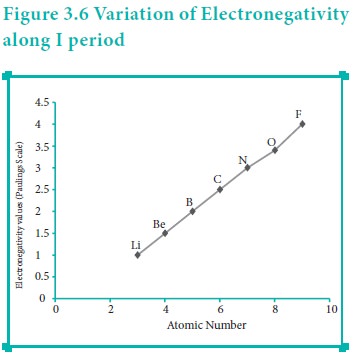

Variation of Electronegativity in a group:
The electronegativity generally decreases down a group. As
we move down a group the atomic radius increases and the nuclear attractive
force on the valence electron decreases. Hence, the electronegativity
decreases.
Noble gases are assigned zero electronegativity. The
electronegativity values of the elements of s-block show the expected
decreasing order in a group. Except 13th and 14th group all other p-block
elements follow the expected decreasing trend in electronegativity.
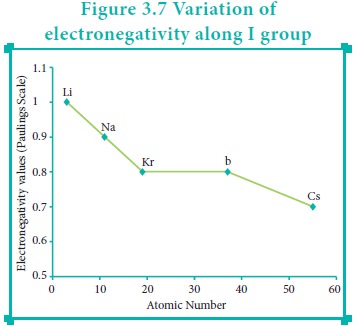
Related Topics